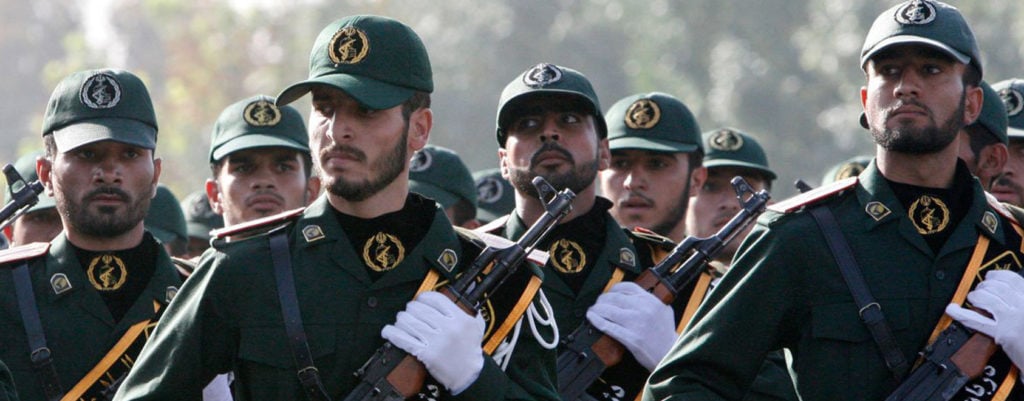
Supreme Leader Khamenei (center) with IRGC Major General Mohammad Ali Jafari (right). (United States Institute for Peace)
On July 14, 2015, the P5+1 (China, France, Germany, Russia, the United Kingdom, and the United States), the European Union (EU), and Iran reached a Joint Comprehensive Plan of Action (JCPOA) regarding Iran’s nuclear program. While the agreement was hailed as a political victory by both Iran and the West, there has been no shortage of tensions since.
On April 20th, the Supreme Court ruled that American victims of terrorist attacks attributed to Iranian operatives should be compensated with impounded assets from Iran’s central bank. The Iranian capture of ten American marines this past January was another flashpoint that threatened to unravel all the progress achieved so far.
The JCPOA calls for the all-around curbing of Iran’s nuclear weapons program (as to be monitored by the International Atomic Energy Association or IAEA) in exchange for the unfreezing of Iranian assets worth some $56 billion and the lifting of a wide array of sanctions that limited dramatically the country’s exports. Iran accepted the deal largely in light of economic incentives, as the lifting of sanctions carried the promise of accelerated economic development. Yet, many political analysts are still suspicious of Iran’s long-term objectives: As money starts to flow to its coffers, will Tehran put its emphasis on sustained economic development, or will it allocate part of these newly-acquired financial resources to fund its proxies in the region?
So far, Iran has been relatively successful in revitalizing its economy. With the lifting of sanctions that denied it access to international markets, the Iranian government now projects that the country will generate an ‘optimistic’ $22.6 billion annually in revenues from crude oil sales, now that the EU—its largest export market—is accessible again. Other countries such as South Korea have already seen dramatic increases in Iranian oil imports, with the number of barrels quadrupling since the lifting of sanctions.
While the nation’s economy is still dominated by oil, Tehran has already negotiated multibillion-dollar automotive and ship manufacturing contracts, attracting the interest of a wide array of countries, from Germany to Japan. Indeed, exponential growth in oil production combined to the flood of foreign investment entering the country is expected to spur growth in the region’s second-largest economy.
Yet, this rosy picture is not entirely accurate and must be qualified. In January, President Rouhani publicly announced that it would require $30-$50 billion worth of foreign investments in order to fulfill the government’s 8% annual growth target, an improbably large sum, despite early successes in attracting foreign direct investments (FDI). Indeed, international investment in oil markets is expected to fall by 18% in 2016, weighing against the Iran’s emergence as a major global oil producer. FDI opportunities in Iran are also plagued by the country difficult relationship with the West—in particular with the United States—as well as Iran’s low governance levels, high corruption and overall difficulty to conduct business.
The lifting of sanctions has also created the opportunity to increase Iran’s military operations in the region. Access to $50-$100 billion worth of previously frozen assets gives Tehran an enhanced ability to project power in the region through financial support for regional proxies such as Hezbollah and various Shi’a militias, and the revamping of its conventional forces and missile program. Since late 2015, online recruitment for Iraqi Shi’a militias engaging in Syria have spiked, causing concerns of an increased presence of Iranian proxies in the war-torn nation.
The decision to allocate 5% of the 2016 national budget to defense, the Russian delivery of S-300 missile defense system and the launch of large-scale military drills of the Islamic Revolutionary Guard Corps, or IRGC, near its border with Pakistan, sends a clear message that although Iran might have given up on its nuclear ambitions for the time being, the regime still not giving up its hegemonic aspirations . Recently, Iran has also faced sanctions for test firing two missiles that are capable of reaching Israel, marked with the inscription “Israel must be wiped off the earth” in Hebrew according to Iranian sources.

The Islamic Revolutionary Guard Corps (IRGC). (Counter Extremism Project)
Increased fund for the military and the IRGC, of course, puts Iran at odds with Western security interests in the region, further decreasing the likelihood of an FDI-fueled economic boom. Thus, Iran is performing a delicate balancing act. While it is indisputable that the regime is using unfrozen assets to jump-start the economy through investment and infrastructure projects, it has also increased military spending to assert its status in the region. If pushed too far, the latter could jeopardize Iran’s future economic prospects.
Found in a ‘guns versus butter’ scenario, Iran must choose how much to allocate toward military or civilian spending based on how it perceives its role in the region to evolve. Simultaneously courting the West and expanding its influence beyond its borders could work in the short-term. But in the short-term only.